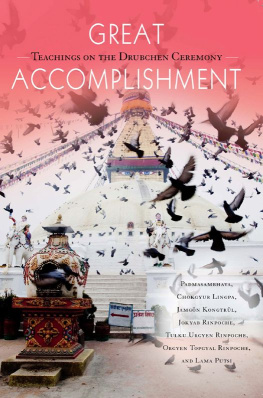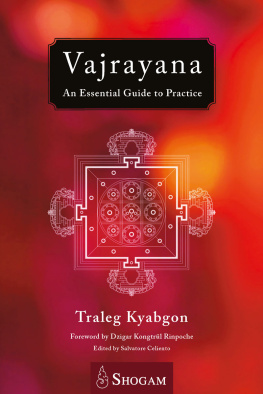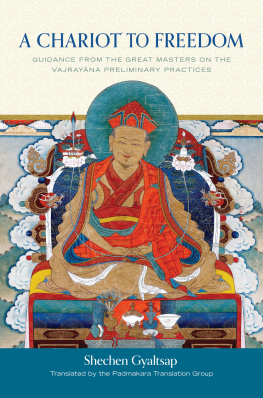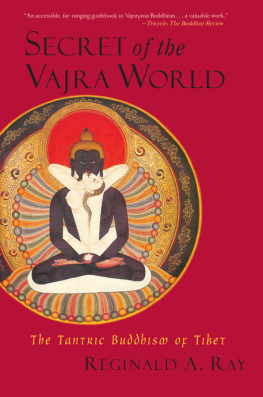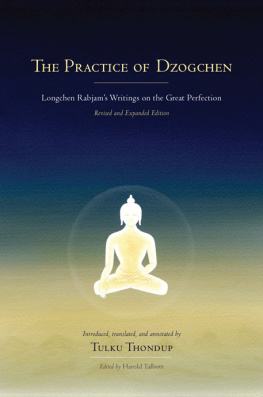R ANGJUNG Y ESHE B OOKS WWW .RANGJUNG.COM
PADMASAMBHAVA Treasures from Juniper RidgeAdvice from the Lotus-BornDakini Teachings
PADMASAMBHAVA AND JAMGN KONGTRL The Light of Wisdom, Vol. 1, Vol. 2, Vol. 3, Vol. 4, & Vol. 5
YESHE TSOGYAL The Lotus-Born
DAKPO TASHI NAMGYAL Clarifying the Natural State
TSELE NATSOK RANGDRL Mirror of MindfulnessEmpowermentHeart Lamp
CHOKGYUR LINGPA Ocean of AmritaThe Great GateSkillful Grace
TRAKTUNG DUDJOM LINGPA A Clear Mirror
JAMGN MIPHAM RINPOCHE Gateway to Knowledge, Vol. 1, Vol. 2, Vol. 3, & Vol. 4
TULKU URGYEN RINPOCHE Blazing SplendorRainbow PaintingAs It Is, Vol. 1 & Vol. 2Vajra SpeechRepeating the Words of the Buddha
ADEU RINPOCHE Freedom in Bondage
KHENCHEN THRANGU RINPOCHE King of Samadhi
CHKYI NYIMA RINPOCHE Present Fresh Wakefulness
TULKU THONDUP Enlightened Living
ORGYEN TOBGYAL RINPOCHE Life & Teachings of Chokgyur Lingpa
DZIGAR KONGTRL RINPOCHE Uncommon Happiness
TSOKNYI RINPOCHE Fearless SimplicityCarefree Dignity
DZOGCHEN TRILOGY COMPILED BY MARCIA BINDER SCHMIDT Dzogchen PrimerDzogchen EssentialsQuintessential Dzogchen
ERIK PEMA KUNSANG Wellsprings of the Great PerfectionA Tibetan Buddhist CompanionThe Rangjung Yeshe Tibetan-English Dictionary of Buddhist Culture & Perfect Clarity
MARCIA DECHEN WANGMO Confessions of a Gypsy Yogini
RANGJUNG YESHE PUBLICATIONS
Flat 5a, Greenview Garden,
125 Robinson Road, Hong Kong
ADDRESS LETTERS TO:
Rangjung Yeshe Publications
Ka-Nying Shedrub Ling Monastery
P.O. Box 1200, Kathmandu, Nepal
www.rangjung.com
Copyright 2013 Rangjung Yeshe Publications
All rights reserved. No part of this book may be reproduced in any form or by any means, electronic or mechanical, including photocopying, recording or by any information storage and retrieval system, without written permission from the publisher
FIRST PAPERBACK EDITION PUBLISHED IN 2013
Distributed to the book trade by:
North Atlantic Books & Random House, Inc.
eISBN: 978-962-7341-83-3
Ocean of Amrita.
Light of Wisdom, Vol. III, Padmasambhava, Chokgyur Lingpa, Jamyang Khyentse Wangpo, Jamgn Kongtrl & Joykyab Rinpoche
Translated from the Tibetan based on the teachings of Kyabje Tulku Urgyen Rinpoche by Erik Pema Kunsang (Erik Hein Schmidt) with Gyurme Avertin.
Edited by Michael Tweed and Marcia Binder Schmidt.
Photo courtesy of Oscar Fernandez
v3.1
CONTENTS
PREFACE
Marcia Dechen Wangmo
Preferring to practice alone, I have always found it difficult to engage in the annual drubchen practices at the monasteries in Nepal. To me, there was just too much color, noise, and people jostling for position and blessings. Moreover, in the monasteries in Nepal, a temporarily more important or wealthy sponsor always squeezed us Westerners out of our seats, even if we had diligently come to practice every day. So, in the midst of the sublime mandala, destructive emotions abounded in my small mind, and I decided it was better to practice alone on the mountainside and avoid all the squabbling, pressure, and complications.
I love sadhanas and practice them daily, so my inability to handle my reactions was a bit of a contradiction, especially in that I considered myself to be a decent meditator. So why did I react differently whether in a crowd or in solitude? My mind is in both places, and if I cannot control it in a group, a religious one at that, then what is the point of identifying oneself as a practitioner at all? I have seen many great Dzogchen meditators, like Kyabje Dilgo Khyentse Rinpoche, preside over many drubchens, unmoved from rigpa, so I did have a clear example of how one could practice.
In any event, for many years I opted to stay away from such public rituals and practice on my own instead. All of that changed when I started to be in the company of Orgyen Topgyal Rinpoche, to work on completing the Light of Wisdom series and the Tukdrub drubchen text, and begin to really learn what drubchen was all about. Suddenly, what previously seemed a burden was a great joy and I began to travel around the world to participate in drubchens. Of course, I always appreciated interacting with sublime beings in the development stage practices, but now I was having a really good time doing it, aside from the sheer exhaustion and complete sensory overload.
It started with a comment by Dzongsar Khyentse Rinpoche about his friend Orgyen Topgyal, where he quoted him saying, The Vajrayana path is basically achieving enlightenment while having fun. My appreciation was also nurtured by performing drubchens at the Rigpa Centers in the West, where order and discipline was the code of behavior, and no wild people or self-important individuals could unseat me. So, in a way, the environment was protected. I certainly did not need to fear for my life with people pushing and stampeding for blessings. But aside from these seemingly small-minded factors, being in the company of many similar-type practitioners and handpicked lamas and monks who knew what they were doing truly inspired me.
And then there were the explanations and teachings, which brings me to this book. They are not new and not something that I had not already studied, but somehow now they hold so much more meaning for me. I experientially appreciated that when serious practitioners come together, replete with their buddha natures, even though covered by temporary obscurations, the power of such a gathering is magnified, and we can collectively accomplish something.
I film the circumambulating of the main mandala repeatedly; it resonates with my gypsy nature. The colors of the streamers waved in space to gather the blessing by realized practitioners is magnetizing and awesome. When I watch the films afterward, each time I witness individuals who know exactly what they are doing, and it is impressive. We too can connect with that blessed energy by one-pointedly engaging in these group assemblies with our fellow yogis and yoginis, who become a support to stabilize awareness in a vivid and heartfelt way. Fortunately, there are many centers in the West that afford the opportunity to connect with drubchens, where the main shrine people and chant masters are Western, and women perform in lama dance as well. I truly rejoice in all this profound Dharma activity that has helped break away at my shell of close-mindedness.
By studying and coming to understand some aspects of the practice and the perfection of those carrying it out correctly, my appreciation for and devotion to the skillful means of Vajrayana has increased, and the next phase is to actually embody it. So, for right now, being the frivolous type, I am enjoying having a really good time, and if I can share that enthusiasm with you, it makes me all the more joyful. Sit back, read, and learn about all the beauty and deep meaning in drubchen, and when you can join one, it will be one of the best choices you will ever make.
INTRODUCTORY TEACHINGS ON THE RITUAL OF GREAT ACCOMPLISHMENT

